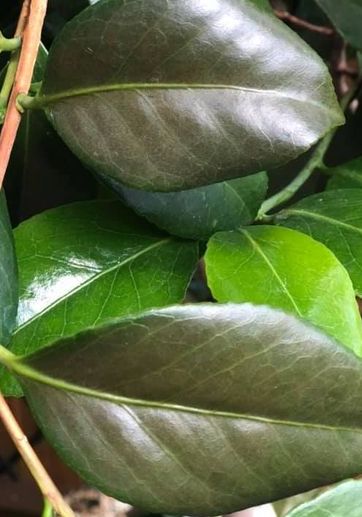Ribbed Tea Mite – Jon.Hall
Jon Hall from Newman’s Nursery was to present this paper at Camellias SA July 2021 Meeting – this was cancelled due to Covid-19 lock down.
Ribbed Tea Mite is commonly referred to as Tea Mite or Purple Camellia Mite and camellias are one of its main host plants.
Called Purple Mite mainly because the body of the insect is purple. Also the term Ribbed Tea Mite because the body of the insect has ‘ribs’ over the length of its body. This is contrary to articles I’ve read that claim the name “ribbed” is due to the insect infesting the veins or ribs of the leaf. In my experience the pest seems to feed on the whole surface of the leaf.
Our climate in SA has low rain fall and generally dry conditions this proves particularly suited to this pathogen. Their numbers increase strongly from spring through summer feeding on the leaves sap, in fact their scissor-like mouthparts pierce leaves to inject their saliva before they suck out a type of pre-digested “soup”. They breed up in their millions, living only a short time, their dead bodies along with the egg shells they hatched from litter the surface of the leaf, giving a dusty appearance to the leaf.
Tea Mite feed on the upper and underside of the leaf causing, along with the dusty appearance, a bronzing on both surfaces. It is believed their saliva can result in plant growth regulator activity, causing infested leaves to turn purple between the veins before russeting and bronzing. Damaged leaves eventually turn brown and drop prematurely hence the sparse woody look of the branches.
Tea Mite are almost microscopic so you would not see the individual insect with the naked eye, even with a magnifying glass it would be hard to detect. The way we become aware of its activity is firstly you notice a slight dustiness to the leaf, looking closer you may start to notice a dulling of the normally glossy foliage along with the slightest change in the leaf colour from glossy dark green to a dull lighter green to a grey green appearance. The leaves showing the initial symptoms will predominantly be those with the most protection.
At this stage your plant will probably still be performing otherwise normally, flowering is not noticeably affected at this stage and spring growth will have its normal fresh glossy green appearance. An increased appearance of ‘dusty’ leaves will become more and more obvious. A gradual deterioration of your camellia will be taking place, the plant will be carrying fewer of its older leaves, the new growth will be shorter and weaker, the plant will start to look sparse and ‘woody’, bud set will be poor and flowers when open will be of poorer size, colour and quality. As this can take several seasons for the plant to look ‘sick’ you often don’t notice this problem until it is an advanced state of infestation.
The very locations we choose for our camellias provides the ideal environment for these mites. When looking for the idea site for a camellia, given the heat we experience in SA naturally we look for shade and protection, as often is the case the site we choose is under an eve of the house, under a veranda or the canopy of a large tree, the very conditions the Tea mite thrive under. These are environments that are sheltered from rain, wind and or air circulation. I have even observed an advanced camellia close to a veranda or eve being heavily infested on the side closest to the veranda or eve and the side facing out from under such protection and receiving regular rain and plenty of air circulation looking seemingly unaffected.
Thankfully an infestation is relatively easy to control, however that being said it still remains difficult to eradicate altogether. To start with you need to adopt a control program where you schedule a spray each spring, summer and again in autumn. While chemical miticides can be very effective and warranted early in your control program, for ongoing treatment I recommend using ‘softer’ options in the way of low or non-toxic treatments, I recommend horticultural oils (Pestoil or Eco-Oil) and soaps (Natrasoap), as these blighters are microscopic, viscous sticky materials like oils and soaps smothering them causing them to cease feeding and breeding, resulting in their death.
Where an infestation has been present for some time, damaged leaves will not recover and some leaf drop will result, subsequent new growth will flourish and maintain a good colour and gloss.Now your plant can function effectively, photosynthesizing and creating starches and sugars to channel into new growth, leaves and eventually beautiful flowers. Time now to ensure your camellia is well fed, watered and repotted (if in need). In spring stimulate growth and improve shape by careful pruning, in time this will go a long way to reduce the sparseness that may have developed.
Applications of Horticultural oils can only be safely applied in temperatures under 30 degrees C and with little likelihood of higher temperatures to follow. Soaps can be used in the hotter periods but it is always safer with any sprays to avoid applying in the heat of the day. In reality it is best to avoid applying these sprays through summer. A spinoff benefit of this treatment is oils and soaps effectively supress other pests that may be impacting your Camellias too. Going forward keep a lookout for any reoccurrence of symptoms and spray before they re-establish.
Other plants are known to host ribbed tea mites are Spathiphyllum and Viburnum varieties.


